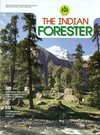Preservative Treatment of Borak (Bambusa balcooa Roxb.) and Ora (Dendrocalamus longispathus(Kurz.) Kurz.) Bamboo Sticks for Betel Leaf Farms
DOI:
https://doi.org/10.36808/if/2018/v144i6/130861Keywords:
Preservative Chemicals, Retention, Penetration, Bamboo Stick.Abstract
Sticks of borak (Bambusa balcooa Roxb.) and ora (Dendrocalamus longispathus (Kurz.) Kurz.) bamboos were treated by soaking methods using water borne preservatives, copper sulphate, sodium dichromate and boric acid (CCB solution). The strips were treated using 5%, 7% and 10% CCB preservatives (2:2:1) aqueous solution by soaking process. The duration of soaking time was 1, 2 and 3 days. The average uptake and retention were measured by weighing the samples before and after the treatment. It was observed that the retention of the preservatives were increased with the increase of time and concentration through the sticks of borak bamboo (B. balcooa Roxb.) and ora bamboo (D. longispathus (Kurz.) Kurz.). After weighing, the samples were split into two portions and penetration was determined by colour test. The extent of penetration of the CCB preservatives in the treated samples were compared with the IS code. It was found that the penetrations of the preservatives were increased with the increase of time through the bamboo sticks. The treated bamboo sticks were distributed to the betel leaf farmers in different areas of Bangladesh. Data were collected after every six months to measure the durability of the bamboo sticks. The preservative treatment technology will expand the service life of the materials and conserve forest resources.References
A.N and Sastry C.B. (6-14 October, 1985). Recent Research on Bamboo. Proceeding of the International Bamboo Workshop, 614 October, 1985. Hangzhan, China.
Akhter K. (2006). Environmental situation on wood preservation industries of Bangladesh. The International Research Group on Wood Preservation (IRG), section 4 (processes), IRG Doc. No. IRG/WP00-50148.7 pp.
Akhter K. and Chowdhury M.H. (2006). CCB Preservative treatment of split mulli bamboo (Melocanna baccifera) by soaking process. Proceedings of 37 Annual Meeting. IRG Tromso, Norway, 18- 22 June, 2006.
Akhter K., De B.C. and Younus-uzzaman M. (1994). Natural durability and treatability of rubber (Heveri brasiliensis) wood, Bangladesh J. Forest Science, 23 (2): 74-78.
Akhter K., Rahman M.M., Salam A. and Chowdhury M.H. (2012) Preservative treatment of baijja (Bambusa vulgaris) and mitinga (Bambusa tulda) bamboo sticks for betel leaf farms. Proceedings of Bamboo Production and Utilization. BARC, Dhaka, 37-42 pp.
Akhter K., Younus-uzzaman M. and Chowdhury M.H. (2001). Preservative treatment of mulli bamboo (Melocanna baccifera ) by pressure process. Proceedings of 32 Annual Meeting. IRG. Nara,Japan, 20-25 May, 2001.
Alam M.K.(1982). A guide to eighteen species of bamboos from Bangladesh. Bulletin 2, Plant Taxonomy Series, Bangladesh Forest Research Institute, Chittagong, 29 pp.
Anon. (1961). Code of practice for preservation of bamboo and cane for non-structural purposes, IS: 1902. Bureau of Indian Standards, New Delhi 3-11 pp.
Anon. (1974). B.S. 4072: Specification for wood preservation by means of water-borne copper-chrome- arsenic compositions. British standard Institution, London, 17 pp.
Banik R.L. (2000). Silviculture and Field-Guide to Priority Bamboo of Bangladesh and South Asia. ISBN 984-753-3. Bangladesh Forest Research Institute, Chittagong, 2000.
Chowdhury M.Y. (1992). Physical and chemical treatments of bamboos for strength and durability. 155-157 pp. in Zhu, S., Li, W, Zhang, X & Wang, Z. (Eds) Bamboo and its Use. International Symposium on Industrial Use of Bamboo, 7-11 December 1992, Beijing, China.
Huda A.S., Mithu M.A., S.M., Islam M.N. and Hannan M.O. (2006). Comparative study between dipping and boucherie method of bamboo preservation. 37 Annual Meeting, IRG. Tromso, Norway, 18-22 June, 2006.
Latif M.A., Dasgupta S.R., DE B.C. and Younus-uzzaman M. (1987). Preservative treatment of bamboo and low cost housing. Bulletin 3, Wood Preservation Series (1987), BFRI. Chittagong.
Liese W. (1980). “Preservation of Bamboosâ€. In: Proceedings on Bamboo Research in Asia. ( Lessard, G. and Chouinard, A. (Eds) 28-30 May, (1980), Singapore; IDRC Ottawa Canada, 165-172 pp.
Liese W. (1985). Bamboo-Biology, Silvics, Properties, Utilisation, Eschborn, Germany :83-90
Liese W. (1997). The protection of bamboo against deterioration. In: Proceedings of second international conference on Nonconventional building (Jena, P.K. ed.). Materials (NOCMAT-97), Bhubaneswar, India, 17-19 June 1997.
Sattar M.A., Kabir M.F and Bhattacharje D.K. (1990). Effect of age and height positions of muli (Melocanna baccifera ) and borak (Bambusa balcooa) bamboos on the physical and mechanical properties. Bangladesh J. Forest Science, 19 (1& 2): 29-37.
Stebbing E.P. (1910). A note on the preservation of bamboo from the attacks of bamboo beatle. Indian Forester, 29(12): 321-22.
Sultani A. (1985). Traditional preservation of bamboo in Java. Indonesia, pp 349.
Tewari M.C. and Singh B.( 1979). Bamboos their utilization and protection against biodeterioration. J. Timber Development Association of India, 25(4): 12-23.
Wu S.C. (1940). Movement of water and chemical solution in ma bamboo and moso bamboo. Mem. Coll. Agric. N.T.U., Taipei, 34(2), 111-123.
Younus-uzzaman M. (1998). Evaluation of Treatment Methods for the Preservation of Bamboo. J. Tropical Forest Products, 4 (1): 52-58.
Younus-uzzaman M. (2004). Durability and preservative treatment of bamboo, Ph. D. thesis, University of Chittagong, Bangladesh: 234pp.
Downloads
Downloads
Published
How to Cite
Issue
Section
License
Unless otherwise stated, copyright or similar rights in all materials presented on the site, including graphical images, are owned by Indian Forester.





